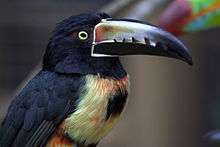Collared aracari
| Collared aracari | |
|---|---|
_-_Belize-0924_-_Toucan.jpg) | |
| In Belize | |
| Scientific classification | |
| Kingdom: | Animalia |
| Phylum: | Chordata |
| Class: | Aves |
| Order: | Piciformes |
| Family: | Ramphastidae |
| Genus: | Pteroglossus |
| Species: | P. torquatus |
| Binomial name | |
| Pteroglossus torquatus (Gmelin, 1788) | |
| Subspecies | |
|
See text | |
The collared aracari (US /ˌɑːrəˈsɑːri/ AHR-ə-SAHR-ee,[2] UK /ˌɑːrəˈsɑːri/ ARR-ə-SAHR-ee or /ˌɑːrəˈkɑːri/ ARR-ə-KAHR-ee)[3] or collared araçari (Pteroglossus torquatus) is a toucan, a near-passerine bird. It breeds from southern Mexico to Panama; also Ecuador, Colombia, Venezuela and Costa Rica.
Taxonomy and systematics
Subspecies
Three subspecies are recognized:[4]
- P. t. torquatus - (Gmelin, 1788): Found in eastern-central Mexico to north-western Colombia
- P. t. erythrozonus - Ridgway, 1912: Found in south-eastern Mexico, Belize and northern Guatemala
- P. t. nuchalis - Cabanis, 1862: Found in north-eastern Colombia and northern Venezuela
Some authourities consider the stripe-billed aracari and the pale-mandibled aracari to also be subspecies of the collared aracari.[5][6]
Description


Like other toucans, the collared aracari is brightly marked and has a large bill. The adult is typically 39–41 cm (15.5–16 in) long and weighs 190–275 g (6.7–9.7 oz)[7] The sexes are alike in appearance, with a black head and chest and dark olive green upperparts, apart from a red rump and upper tail. There is reddish collar on the rear neck which gives rise to the English and scientific (torquatus) names. The underparts are bright yellow, with a round black spot in the centre of the breast and a red-tinted black band across the belly. The thighs are chestnut.
The bare facial skin is black, becoming ruddy behind the yellow eye. The upper mandible of the bill is dull yellow, marked with a black saw-tooth pattern on the cutting edge, and a black tip. The lower mandible is black, and the legs are green.
Juvenile collared aracaris are much duller, with sooty-black head and brownish green upperparts. The red rump and yellow underparts are paler, and the breast spot, belly band and bill pattern are indistinct.
The call of the collared aracari is a loud, sharp pseek, or peeseek.
Behaviour and ecology
Small flocks, usually consisting of 6-15 birds, move through the forest with a rapid direct flight.
Breeding

The collared aracari is a common resident breeder in lowland forests and slightly more open woodland. The 3 white eggs are laid in an unlined natural cavity or old woodpecker nest high in a tree.
Both sexes incubate the eggs for about 16 days, and the toucan chicks remain in the nest after hatching. They are blind and naked at birth, and have short bills and specialised pads on their heels to protect them from the rough floor of the nest. They are fed by both parents, assisted by up to three other adults, probably from a previous brood, and fledge after about 6 weeks, with feeding by the adults continuing for several weeks after leaving the nest.
The aracaris are unusual for toucans in that they roost socially throughout the year, up to six adults and fledged young sleeping in the same hole with tails folded over their backs.
Food and feeding
This species is primarily an arboreal fruit-eater, but will also take insects, lizards, eggs, and other small prey.
References
- A guide to the birds of Costa Rica by Stiles and Skutch ISBN 0-8014-9600-4
- ↑ BirdLife International (2013). "Pteroglossus torquatus". IUCN Red List of Threatened Species. Version 2013.2. International Union for Conservation of Nature. Retrieved 26 November 2013.
- ↑ "Aracari". Dictionary.com Unabridged. Random House, Inc.). Retrieved 2012-04-20.
- ↑ "Definition for aracari". Oxford Dictionaries Online. Retrieved 2012-04-20.
- ↑ "IOC World Bird List 6.4". IOC World Bird List Datasets. doi:10.14344/ioc.ml.6.4.
- ↑ "Aulacorhynchus sanguineus- Avibase". avibase.bsc-eoc.org. Retrieved 2016-11-05.
- ↑ "Aulacorhynchus erythropygius- Avibase". avibase.bsc-eoc.org. Retrieved 2016-11-05.
- ↑ "Archived copy". Archived from the original on 2007-08-19. Retrieved 2007-08-18.
External links
- El Jardín Diostede information on raising and keeping collared aracaris as pets
- Collared aracari videos, photos & sounds on the Internet Bird Collection
- Stamps (for Belize, El Salvador) with RangeMap
- Collared aracari in captivity
- Collared aracari photo gallery at VIREO (Drexel University)
